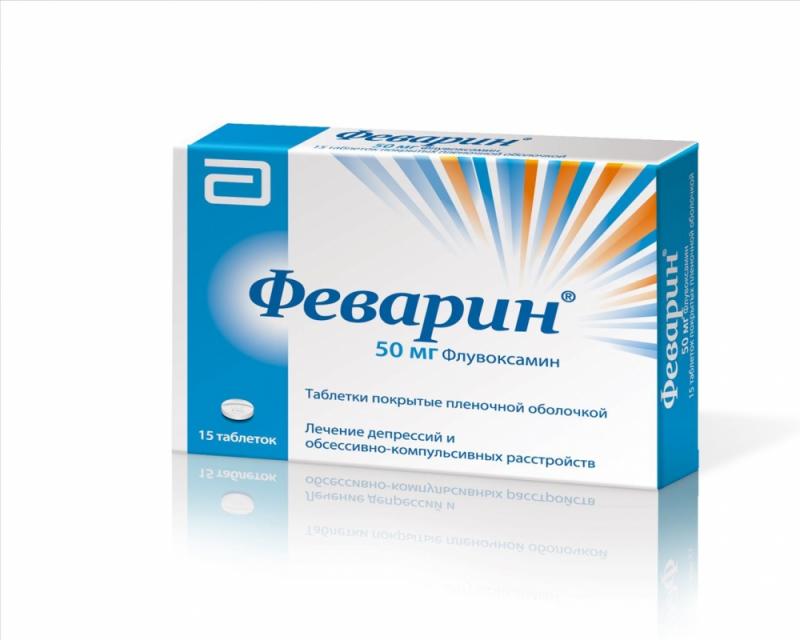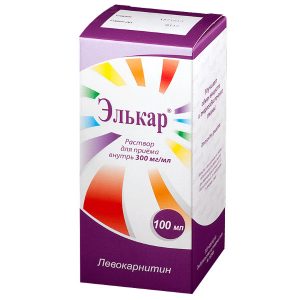Description
Release form
Tablets
Packaging
15 pcs
Pharmacological action
FEVARIN – antidepressant. The mechanism of action is associated with selective inhibition of serotonin reuptake by brain neurons and is characterized by a minimal effect on noradrenergic transmission. Fevarin has a weak ability to bind to – and -Adrenoreceptors, histamine, m-cholinergic receptors, dopamine and serotonin receptors.
Indications
– treatment and prevention of depression
– treatment of symptoms of obsessive-compulsive disorders.
Contraindications
– simultaneous use with tizanidine
– simultaneous use with MAO inhibitors (the interval between the withdrawal of an MAO inhibitor and the start of treatment with Fevarin should be at least 2 weeks)
– children under 8 years of age
– increased sensitivity to other fluvox or other the components of the drug.
Pregnancy and lactation
Epidemiological data suggest that the use of selective serotonin reuptake inhibitors in the last month of pregnancy, pregnancy, may increase the risk of persistent pulmonary hypertension (PLH) in newborns. Available data show that PLH occurs in approximately 5 cases per 1000 births (in contrast to 1-2 cases per 1000 births, if the mother did not use SSRIs in the last stages of pregnancy).
The use of fluvoxamine during pregnancy is not recommended, unless the clinical condition of the woman indicates the need for its use.
Cases of withdrawal syndrome in newborns after fluvoxamine use at the end of pregnancy have been described.
In some newborns after exposure to SSRIs in the third trimester of pregnancy, feeding and / or breathing difficulties, convulsive disorders, unstable body temperature, hypoglycemia, tremors, muscle tone disorders, increased neuro-reflex irritability syndrome, cyanosis, irritability, lethargy, drowsiness, nausea difficulty falling asleep and continuous crying, which may require longer hospitalization.
Fluvoxamine passes into breast milk in small amounts. In this regard, the drug should not be used during lactation.
Fluvoxamine should not be prescribed to patients who are planning a pregnancy, unless the patient’s clinical condition requires the administration of fluvoxamine.
Experimental studies of reproductive toxicity in animals have shown that fluvoxamine affects the reproductive function of males and females, increases the risk of fetal death and reduces fetal body weight in doses exceeding the maximum recommended dose for humans by about 4 times. In addition, an increase in the frequency of perinatal mortality of puppies was observed in pre- and postnatal studies. The significance of these data to humans is unknown.
Special instructions
As with other psychotropic drugs, alcohol is not recommended during treatment with Fevarin.
Depression is associated with an increased risk of suicidal thoughts, self-harm, and attempted suicide (suicidal behavior). This risk persists until significant improvement. Since improvement may not occur during the first few weeks of treatment or longer, patients should be closely monitored until such improvement appears.
In clinical practice, an increased risk of suicide in the early stages of recovery is widespread.
Other mental disorders for which fluvoxamine is prescribed may also be associated with an increased risk of suicidal behavior. In addition, these conditions may be associated with severe depression. Therefore, patients with other mental disorders should be closely monitored.
It is known that patients with a history of suicidal behavior or who show a significant degree of suicidal ideation, before starting treatment, have a greater risk of suicidal thoughts or suicidal attempts and must be carefully observed during treatment.
Careful monitoring of patients, especially those at high risk, should accompany drug therapy, especially in its early stages and after dose changes.
Patients (and individuals caring for them) about the need to monitor any clinical deterioration, suicidal behavior or suicidal thoughts, unusual changes in behavior, and immediately consult a specialist if such symptoms occur.
The development of akathisia associated with the administration of fluvoxamine is characterized by subjectively unpleasant and painful anxiety. The need to move was often accompanied by an inability to sit or stand still. The development of this condition is most likely during the first few weeks of treatment. Increasing the dose of the drug in patients with such symptoms may worsen their condition.
Caution must be exercised when administering the drug to patients with a history of seizures. Avoid fluvoxamine administration in patients with unstable epilepsy, and patients with stable epilepsy should be closely monitored. Treatment with Fevarin must be discontinued if epileptic seizures occur or their frequency increases.
Rare cases of the development of a serotonergic syndrome or a condition similar to ZNS, which may be associated with fluvoxamine, are described, especially in combination with other serotonergic and / or antipsychotic drugs. These syndromes can lead to potentially life-threatening conditions, manifested by hyperthermia, muscle rigidity, myoclonus, lability of the autonomic nervous system with possible rapid changes in vital parameters (including pulse, respiration, blood pressure), changes in mental status, including confusion, irritability, extreme agitation, reaching delirium or coma. Therefore, in such cases, Fevarin should be discontinued and appropriate symptomatic treatment should be initiated.
As with other selective serotonin reuptake inhibitors, hyponatremia, which undergoes reverse development after the withdrawal of fluvoxamine, is possible in rare cases. Some cases have been caused by ADH secretion syndrome. These cases were mainly observed in elderly patients.
Control of blood glucose levels (i.e., hyperglycemia, hypoglycemia, impaired glucose tolerance) may be impaired, especially in the early stages of treatment. In the case of the appointment of Fevarin to patients with a history of diabetes mellitus, a dose adjustment of hypoglycemic drugs may be required.
The most frequently observed symptom associated with the use of Fevarin is nausea, sometimes accompanied by vomiting. This side effect usually disappears during the first 2 weeks of treatment.
Cases of mydriasis have been reported with SSRIs, such as fluvoxamine. Therefore, patients with increased intraocular pressure or patients at increased risk for acute angle-closure glaucoma should be given fluvoxamine with caution.
There are reports of intradermal hemorrhages such as ecchymosis and purpura, as well as other hemorrhagic manifestations (such as gastrointestinal bleeding or gynecological bleeding) observed with the use of selective serotonin reuptake inhibitors. Caution should be exercised when prescribing these drugs in elderly patients and patients simultaneously receiving drugs that act on platelet function (for example, atypical antipsychotics and phenothiazines, many tricyclic antidepressants, acetylsalicylic acid, NSAIDs) or drugs that increase the risk of bleeding, as well as in patients with a history of bleeding or who are prone to bleeding (for example, with thrombocytopenia or impaired coagulation).
Increased risk of prolonged QT / paroxysmal ventricular tachycardia interval of the pirouette type during combination therapy with fluvoxamine with terfenadine or astemizole or cisapride, due to an increase in the concentration of the latter in blood plasma. Therefore, fluvoxamine should not be prescribed along with these drugs.
Fluvoxamine may cause a slight decrease in heart rate (2-6 beats / min).
Experience with the clinical use of fluvoxamine with ECT is limited, so this therapy should be carried out with caution.
With the discontinuation of fluvoxamine, withdrawal syndrome may develop, although available data from preclinical and clinical studies have not revealed any dependence on treatment with fluvoxamine. The most common symptoms noted with discontinuation of the drug are dizziness, sensory disturbances (including paresthesia, visual disturbance, and sensation by a shock), falling asleep (including insomnia and vivid dreams), irritability, irritability, confusion, emotional lability, headache, nausea, and / or vomiting, diarrhea, sweating, palpitations, tremors, and anxiety. Most of these symptoms are mild or moderate in nature and stop on their own, but in some patients they can be severe and / or prolonged. Similar symptoms usually occur within the first few days after discontinuation of treatment. For this reason, it is recommended to gradually reduce the dose of fluvoxamine before complete withdrawal in accordance with the patient’s condition.
Fluvoxamine should be used with caution in patients with a history of mania / hypomania. If the patient develops a manic phase, the use of fluvoxamine should be discontinued.
Treatment of patients with hepatic or renal failure should begin with the appointment of the drug in a low dose, such patients require strict medical supervision. In rare cases, treatment with fluvoxamine can lead to an increase in the activity of liver enzymes, which is most often accompanied by the corresponding clinical symptoms, in such cases Fevarin should be discontinued.
data, obtained in the treatment of elderly patients and younger patients indicate the absence of clinically significant differences between the daily doses normally used in them. However, increasing doses of the drug in elderly patients should always be slower and with more caution.
A meta-analysis of placebo-controlled clinical trials of antidepressants in adult patients with mental disorders revealed an increased risk of suicidal behavior when taking antidepressants compared with placebo in patients under 25 years of age. When prescribing fluvoxamine, the risk of suicide and the benefits of its use should be correlated.
Composition of
Fluvoxamine maleate
Excipients: mannitol, corn starch, pregelatinized starch, sodium stearyl fumarate, anhydrous colloidal silicon dioxide, methylhydroxypropyl cellulose, polyethylene glycol 171, polyethylene glycol.
Dosage and administration of
In the treatment of depression, the recommended starting dose is 50 mg or 100 mg 1 time / day, in the evening. Increasing the dose should be carried out gradually. An effective dose, usually 100 mg / day, is selected individually depending on the patient’s response to treatment. The daily dose can reach 300 mg.
Doses greater than 150 mg / day should be divided into several doses.
According to official WHO guidelines, antidepressant treatment should be continued for at least 6 months after the cure of the depressive episode.
For the prevention of relapse of depression, Fevarin is recommended to be prescribed at a dose of 100 mg 1 time / day.
In the treatment of obsessive-compulsive disorders, the recommended starting dose is 50 mg / day for 3-4 days. Increasing the dose should be carried out gradually until an effective daily dose is reached, which is usually 100-300 mg. The maximum effective dose for adults is 300 mg / day. Doses up to 150 mg can be taken 1 time / day, preferably in the evening. Doses of more than 150 mg / day are recommended to be divided into 2 or 3 doses.
For children over 8 years of age and adolescents, the initial dose is 25 mg / day for 1 dose. The maintenance dose is 50-200 mg / day. The maximum dose is 200 mg / day. Doses of more than 100 mg / day are recommended to be divided into 2 or 3 doses.
With the development of an adequate therapeutic effect, treatment can be continued with an individually selected daily dose. If improvement is not achieved after 10 weeks of treatment, Fevarin should be discontinued. Given that obsessive-compulsive disorders are chronic, it may be considered advisable to extend the course of treatment with Fevarin for more than 10 weeks in patients with an adequate therapeutic effect. The selection of the minimum effective maintenance dose should be carried out individually and with caution. Some clinicians recommend concomitant psychotherapy in patients with a good pharmacotherapy effect.
In patients with hepatic or renal failure, treatment should be started with the lowest dose under strict medical supervision.
Fevarin tablets should be taken without chewing and with a little water.
Side effects
Some side effects, observed during clinical trials were often associated with the disease, and not with treatment with Fevarin. All reactions are distributed by organ systems and developmental frequency: often (> 1% and0.1% and0.01% and
From the blood coagulation system: frequency unknown – bleeding (for example, gastrointestinal bleeding, gynecological bleeding, ecchymosis, purpura)
From the endocrine system: frequency unknown – hyperprolactinemia, inadequate ADH production syndrome
Metabolism and nutrition: often – anorexia frequency unknown – hyponatremia, weight loss, weight gain
Mentality: infrequently – gal lucination, a state of confused consciousness is rare – mania frequency is unknown – suicidal thinking, suicidal behavior.
From the nervous system: often – anxiety, increased irritability, anxiety, insomnia, drowsiness, tremor, headache, dizziness infrequently – extrapyramidal disorders, ataxia rarely – convulsions frequency unknown – serotonin syndrome, central nervous system, akathisia / psychomotor agitation, paresthesia, dysge .
From the side of the organ of vision: the frequency is unknown – glaucoma, mydriasis.
From the cardiovascular system: often – palpitations, tachycardia infrequently – orthostatic hypotension.
From the digestive system: often – abdominal pain, constipation, diarrhea, dry mouth, dyspepsia, nausea, vomiting rarely – impaired liver function (increased activity of liver enzymes).
From the skin and subcutaneous tissue: often – increased sweating infrequently – skin hypersensitivity reactions (including rash, itching, angioedema) rarely – photosensitivity reactions.
From the musculoskeletal system: infrequently – arthralgia, myalgia, frequency unknown – broken bones. *
From the urinary system: frequency unknown – impaired urination (including urinary retention, urinary incontinence, pollakiuria, nocturia and enuresis).
On the part of the reproductive system: infrequently – impaired (delayed) ejaculation rarely – galactorrhea frequency unknown – anorgasmia, irregular menstruation (such as amenorrhea, hypomenorrhea, metrorrhagia, menorrhagia).
General disorders: often – asthenia, malaise, frequency is unknown – drug withdrawal syndrome, including withdrawal syndrome in newborns, whose mothers took fluvoxamine late in pregnancy.
* – epidemiological studies performed mainly with patients aged 50 years and over showed an increased risk of bone fractures in patients treated with SSRIs and tricyclic antidepressants. The mechanism for increasing risk is unknown.
Withdrawal syndrome after discontinuation of fluvoxamine
Discontinuation of fluvoxamine (especially abrupt) often leads to the development of withdrawal syndrome. For this reason, if treatment with fluvoxamine is no longer required, it is recommended to gradually reduce the dose until the drug is completely discontinued.
Drug Interactions
Fluvoxamine cannot be used in combination with MAO inhibitors, including linezolid, because of the risk of developing serotonin syndrome.
Fluvoxamine can inhibit the metabolism of drugs that are metabolized by certain cytochrome P450 isoenzymes. In vitro and in vivo studies have shown the potent inhibitory effect of fluvoxamine on cytochrome P450 1A2 and 2C19 isoenzymes and to a lesser extent on cytochrome P450 2C9, 2D6 and 3A4 isoenzymes.
Drugs that are largely metabolized by these isoenzymes are more slowly excreted and may have higher plasma concentrations, in case of simultaneous use with fluvoxamine. Such drugs should be prescribed in the minimum dose or reduce the dose to the minimum while using fluvoxamine. Careful observation of plasma concentrations, effects or side effects, as well as dose adjustment of these drugs, if necessary, is required. This is especially significant for drugs that have a narrow therapeutic range.
When taking Fevarin 100 mg 2 times / day for 3 days before the simultaneous use of ramelteon in a dose of 16 mg, the AUC value for ramelteon increased approximately 190 times, and the Cmax value increased approximately 70 times compared with these parameters when prescribed one ramelteon.
Patients taking fluvoxamine and drugs with a narrow therapeutic range at the same time, metabolized solely or by a combination of cytochrome P450 isoenzymes inhibiting fluvoxamine (such as tacrine, theophylline, methadone, mexiletine, phenytoin, carbamazepine and cyclosporine) should be closely monitored. If necessary, a dose adjustment of these drugs is recommended.
With the simultaneous use of fluvoxamine, an increase in the concentration of tricyclic antidepressants (e.g. clomipramine, imipramine, amitriptyline) and antipsychotics (e.g. clozapine, olanzapine, quetiapine), which are significantly metabolized by the cytochrome P450 1A2 isoenzyme, was observed. In this regard, if fluvoxamine treatment is started, the dose reduction of these drugs should be considered.
When used simultaneously with fluvoxamine, benzodiazepines undergoing oxidative metabolism, such as triazolam, midazolam, alprazolam and diazepam, it is possible to increase their concentration in plasma. The dose of these benzodiazepines should be reduced by the time of administration of fluvoxamine.
With the simultaneous use of fluvoxamine and ropinirole, the concentration of ropinirole in the plasma may increase, thereby increasing the risk of overdose. In such cases, it is recommended to control, or, if necessary, reduce the dose or cancel ropinirole during treatment with fluvoxamine.
In the interaction of fluvoxamine with propranolol, an increase in plasma concentrations of propranolol was noted. In this regard, it is possible to recommend a reduction in the dose of propranolol in case of simultaneous use with fluvoxamine.
When using fluvoxamine in combination with warfarin, a significant increase in plasma concentrations of warfarin and a prolongation of prothrombin time were observed.
Isolated cases of cardiotoxicity have been reported with the simultaneous use of fluvoxamine and thioridazine.
During the administration of fluvoxamine, the plasma caffeine concentration may increase. Thus, patients who consume large amounts of caffeinated drinks should reduce their intake during the period of taking fluvoxamine, and when adverse effects of caffeine are observed, such as tremors, palpitations, nausea, anxiety, and insomnia.
In combination therapy with fluvoxamine, plasma concentrations of terfenadine, astemizole, or cisapride may increase, increasing the risk of prolonging the QT / paroxysmal ventricular tachycardia interval such as pirouette. Therefore, fluvoxamine should not be prescribed along with these drugs.
Fluvoxamine has no effect on plasma digoxin concentration.
Fluvoxamine does not affect plasma atenolol concentrations.
In the case of combined use of fluvoxamine with serotonergic drugs (such as triptans, tramadol, selective serotonin reuptake inhibitors and hypericum perforatum), the serotonergic effects of fluvoxamine may be enhanced.
Fluvoxamine has been used in combination with lithium preparations to treat severely ill patients who respond poorly to pharmacotherapy. It should be noted that lithium (and possibly also tryptophan) enhances the serotonergic effects of the drug, and therefore this kind of combination pharmacotherapy should be carried out with caution.
With the simultaneous use of indirect anticoagulants and fluvoxamine, the risk of hemorrhage may increase. Such patients should be monitored by a physician.
Overdose
Symptoms: nausea, vomiting, diarrhea, drowsiness, dizziness most characteristic. There are reports of cardiac disorders (tachycardia, bradycardia, hypotension), liver function disorders, convulsions, coma.
To date, there have been over 300 reports of cases of deliberate overdose with Fevarin. The highest recorded dose was 10 g (the patient was cured as a result of symptomatic therapy). More serious complications were observed in cases of deliberate overdose of Fevarin on the background of concomitant pharmacotherapy.
Treatment: gastric lavage, which should be carried out as early as possible after receiving the drug, conduct symptomatic therapy. Repeated intake of activated charcoal is also recommended. There is no specific antidote. Forced diuresis or dialysis are impractical.
Storage conditions
The product should be stored in dry, direct sunlight, out of reach of children, at a temperature not exceeding 25 ° C.
Shelf life
3 years
Deystvuyushtee substance
Fluvoxamine
Terms and conditions
prescription
dosage form
tablets
Possible product names
FEVARIN 0.05 N15 TABLE P / O
Fevarin 50mg Tab. p / pl / rev X15
Fevarin 50mg No. 15
FEVARIN 50MG. No. 15 TAB. P / O
Fevarin tablets 50 mg N15




